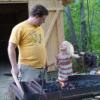-
Posts
11 -
Joined
-
Last visited
Content Type
Profiles
Forums
Articles
Gallery
Downloads
Events
Posts posted by Illi
-
-
Thanks for the replies everyone. If it is true that he's reselling, then he's making a lot of money. The one I linked above is already going for double the original seller's price. And then there's this one which went for ~$234:
It sure looks a lot like this $80 cone from Kayne & Sons:
I guess it does pay to shop around.
-
Is there an easy way to determine if a tool (such as an anvil cone) is made of cast steel vs. cast iron vs. ductile iron? The reason I ask is that this cone is cast steel according to the seller (because it rings):
However, it looks VERY similar (length of the hardy post, the placement of the serial (or whatever it is) near the bottom rim of the cone, the angle of the cone, as well as the surface texture) to this cone, which is advertised as ductile iron:
To summarize my questions:
1) In general, is it possible to tell different materials apart based on the surface texture of the casting, or is the surface texture a function of the mold rather than the poured material?
2) Does ductile iron ring like steel?
As a side note, are ductile iron tools worth buying?
Thanks
-
HWooldridge
You essentially made you stack taller which will automatically increase the draft. I don't believe the velocity of the smoke is fast enough to actually draw in much ambient air through that annular space. In any case mixing ambient air with your hot smoke would be counter-productive because you would be lowering the temperature of the mixed air. That would work against you. Just make your stack taller, it's simpler anyway.
I'm not sure, but I think the effect may be due to wind blowing across the top of the collar creating a negative pressure; increasing the cross-sectional area of the top of the stack would(?) result in more force pulling the smoke up the pipe (PSI times a larger area is a larger number of pounds). As with the turbine, I think this effect would likely be most helpful when the stack is cold and you're trying to start a draft. Once a good draft is going, I think that the draft would be the dominant effect. -
I am not able to help on the spacers for your application, but you can get the fibrous washers from McMaster Carr.
http://www.mcmaster.com/#standard-washers/=cuh6v9
Thanks, I'll check them out and see what I can find. -
I recently purchased a Royal Western Chief; during disassembly (how else could I see how the innards work?) and cleaning out the old sludge, I noticed that there are washers on either end of all the gears. These washers are made out of some sort of very stiff paper (or some other fibrous material) and seem to be used to maintain spacing between the gears and the casting - are these indeed spacers? Does anyone know where I can purchase either actual spacers or the material to make them? Some of the spacers were shredded so as a temporary fix I replaced them with gasket material but I suspect that the gasket stuff isn't as strong as the original spacers.
Thanks,
-J -
look under it
Not sure, but I guess you're thinking of this:http://cgi.ebay.com/...=item19c2871fd7
*drool*
-J -
Regarding the soft Kohlswa anvils of the 80s, is there a list of affected serial numbers, or is there some other way to tell if an anvil (particularly a potential eBay purchase such as the 54 pounder on auction now) will likely have a soft face?
-
54 lb Kohlswa in (very) southern NY state. Looks pretty much pristine to me:
http://cgi.ebay.com/Anvil-54lbs-KOHLSWA-Sweden-/120667974491?pt=LH_DefaultDomain_0&hash=item1c185f2b5b
Even if the seller does offer local pickup, I'm not willing to drive through NY city to get an anvil.
-J


Hardy anvil cone material identification
in Tools, general discussion
Posted
My theory is that people have this mindset that "ebay has deals". The see something on ebay and simply assume that it's going for less than they could buy direct elsewhere. That was much more true when there were fewer buyers (less of a market). Now that everyone is on ebay I think it is much more likely that multiple people are interested in the same item.
The other possibility in this case is that people are bidding higher because the seller *thinks* the cones are made of steel not ductile iron.
Talk about a good return on your investment though; more than double in a couple weeks. All you need to do is "shade" the truth by saying that you *think* it's made of steel rather than ductile iron.